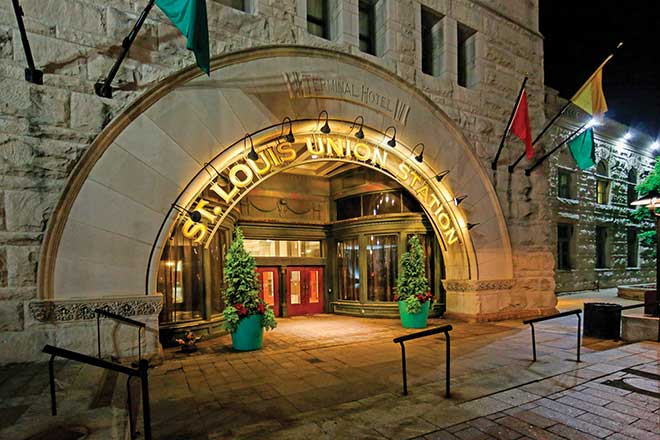When the last commuter train pulled out of Union Station in 1978, the future of the 20-acre complex was uncertain. For a few years, its doors were simply closed. By 1985, Union Station reopened after renovations transformed it into a hotel, shopping and entertainment center. Despite the massive changes, Union Station still couldn’t re-establish itself as the premier stop between the east and west coasts, a title it firmly claimed in the 1890s when it was the busiest and largest train station in the world.
That is changing, however. After buying the property in 2012, Lodging Hospitality Management has combined the structure’s historic past with modern-day amenities. LHM’s $40 million in renovations transport people back to the landmark’s original glory days. “It is so unique,” says Todd Hotaling, LHM vice president of revenue and marketing. “You’re not going to find this type of elegant architecture anywhere.”
That elegance has been uncovered in places the company never expected. “In the Grand Hall, when we pulled up the existing flooring, we uncovered the floor from 100 years earlier, and it was perfect,” Hotaling says. “That is what you walk on today.” Architect Theodore Link designed Union Station in the Romanesque style. The structure was built with Bedford stone, but its beauty goes much deeper than the often-photographed exterior.
Recently completed renovations include the Gothic Corridor, which sits along Market Street near the front desk. It is another example of how the magnificent structure’s past is being preserved, with onlookers able to see the original glazed Italian terracotta tiles, gold leafing and mosaic tile with fleur de lis design. “It’s my favorite room in the whole hotel,” Hotaling says. “It’s a gorgeous space in Union Station that clients can use for small gatherings.”
The general public is welcome at anytime to view Gothic Corridor and other of the station’s historic highlights, like the seven ladies adorning each end of the Grand Hall archway and the allegorical window. The stained-glass window consists of three women, each representing one of the main U.S. train stations in the late 18th century. “It is so interesting, and it’s all the original stained glass,” Hotaling says of the window designed by Sylvester Annan from the St. Louis firm of Davis & Chambers. “There is nothing formal written on what the design was. But St. Louis sits between San Francisco and New York, so one story is that both coasts are looking inward in envy of our train station. The pride of St. Louis is really represented well there.”
While preserving history, LHM is adding all the modern amenities current travelers desire, and sometimes the two collide. In the process of adding a Starbucks to one area, workers uncovered a massive mural hidden behind a wall. The 1942 art by Chicago artist Louis Grell now hangs behind the front desk.
Another area where the new and old meet is the Terminal Hotel. Originally, the area housed railroad employees with the simplest of accommodations. Its entrance has been restored to its past glory, but now the interior of each room has been transformed with top-of-the-line accommodations. History is hardly lost among the four-diamond service, however. Each room has a specific railway line name and is adorned with photos from when Union Station was buzzing with travelers. “It’s truly a one-of-a-kind hotel experience in St. Louis,” Hotaling said.
Pictured: Terminal Hotel entrance
Photo courtesy of Union Station
Union Station is a National Historic Landmark located at 1820 Market St. in downtown St. Louis. For more information on scheduling a business gathering in the gothic corridor or for other inquiries, call 314.621.5262 or visit stlouisunionstation.com. Pictured on the cover: The Gothic Corridor
Cover design by Allie Bronsky | Cover photo courtesy of Union Station








